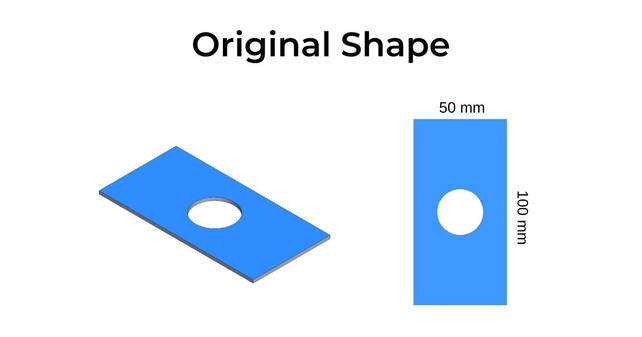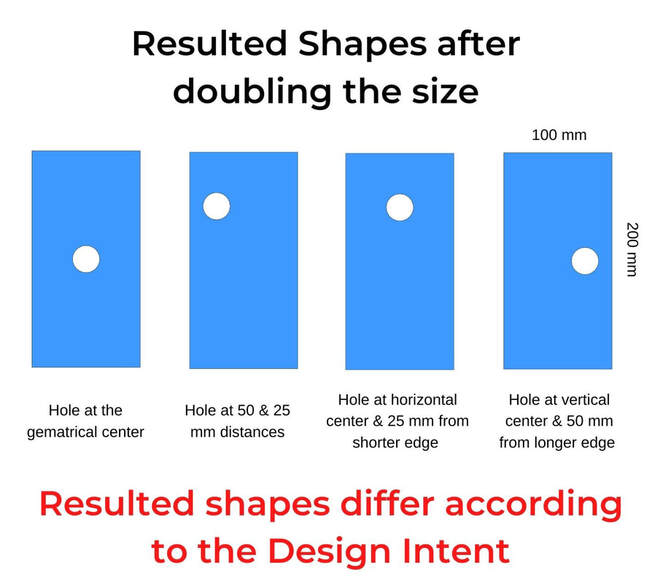|
One of the most critical elements in designing intelligently in parametric modeling is considering Design Intent. So, what is Design Intent, and why is it important. We will talk about all that here in this post. In a nutshell, Design Intent is what you want your design to do. Maintaining your Design intent through the design means telling the software what you want the design to do or how it should behave. Another term often used for this is 'Modeling Intent'. Let us look at a simple example. We were given a 100 x 50 mm rectangular disk and asked to make a 25 mm diameter hole through it. Here are four different ways to position the center of the hole.
Even though the result is the same, each of the instructions asks the design to behave differently. This will show when trying to modify the design. Let us assume that we were requested to change the rectangle's longer side from 100 mm to 200 mm and the smaller side from 50 to 100 mm. Let us make this change and see the result have we followed each of the given instructions. The figure below shows the result. From the results, the difference is quite notable. Note that none of the designs are wrong. It is just that each has behaved differently according to what we told the software what is important to us. In other words, the design acted according to our Design Intent. Considering and applying your design intent in your 3D modeling procedure takes more time and effort at the beginning. However, it saves lots of time at later stages when applying modifications to your design. Mostly talking, you will be continuously modifying your designs throughout the development cycle, making considering and impeding the Design Intent in your 3D models essential. Where does Design Intent Apply when 3D Modeling?The simple example explored earlier was in a sketch and an overall simple part. However, the same applies to applying features, making assemblies, and generating drawings. The more complex your designs are, the more critical it is to maintain your design intent throughout. 3D Modeling tools like SOLIDWORKS and others have many different tools to help you maintain your design intents. Major ones include Equations, In-context Features, and multi-body modeling approach. Other than Saving Time, Why Implement Design Intent?Maintaining Design Intents makes it easier for more than one person to work on the same design. This is because all involved persons would have a clear idea of what the design should do. Thus, when one person modifies another's design, they would know how the design should behave and continue to maintain that desired behavior. Let us summarize the key points in design intent:
If you are looking to learn SOLIDWORKS from experienced users, you can check out the TforDesign online school for professional courses with learner support. By Tayseer Almattar, TforDesign FounderTayseer is the founder of TforDesign. He has a passion for learning design and making all learning digestible and exciting.
LinkedIn: https://www.linkedin.com/in/tayseer-almattar-design-innovation
5 Comments
Eddie Lai
12/18/2020 01:32:28 pm
Thank you for starting out your course with this important fundamental concept! This gives me great confidence in your teaching.
Reply
Bilal Mustafa
6/29/2021 03:30:15 am
The teaching methodology used by TforDesign team is the most structured and effective one.
Reply
5/25/2022 06:10:10 am
I want to get a building made, but I'm not sure how to put it together. It makes sense that getting a 3D model of it would be a good idea. That way, I can have a good way to visualize the project.
Reply
Steve Kenney
7/3/2022 05:13:59 pm
Thank you for putting this little nugget together. I'm now retired, but am an experienced 3D Designer using Pro/Engineer - Wildfire from the early 90's to 2015. Now I just dabble in Fusion360 as part of my 3D printing hobby. I have expressed maintaining 'Design Intent' and still express this to every beginner modeler (and some experienced ones) over the years!! Being able to share this page with them makes it so much easier. Thanks, Steve
Reply
Leave a Reply. |
AuthorThe following blogs are written by TforDesign team and community members. Categories
All
|
© 2013 - 2024 TforDesign. All rights reserved.
Terms & Conditions | Privacy Policy | Cookie Policy | Sitemap
Terms & Conditions | Privacy Policy | Cookie Policy | Sitemap




 RSS Feed
RSS Feed